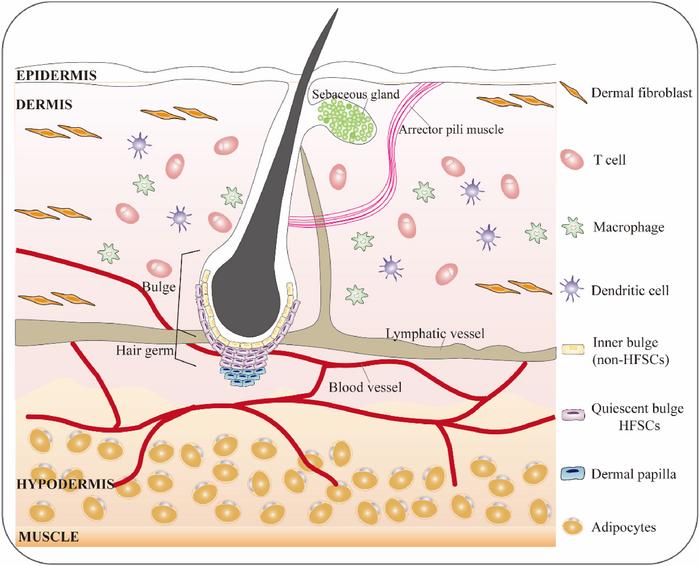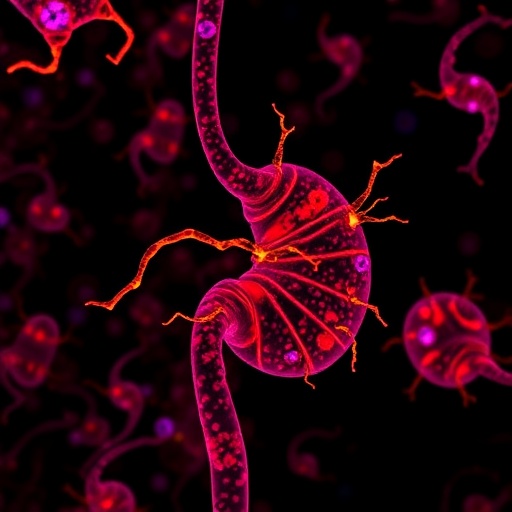
Recent breakthroughs in dermatological research are redefining our understanding of hair follicle biology by spotlighting the pivotal role of dermal T cell immunity in hair regeneration and the pathogenesis of immune-mediated alopecias. This cutting-edge perspective elucidates how intricate immune mechanisms not only protect but also govern hair follicle cycling, unraveling novel therapeutic avenues for managing hair loss disorders that have historically eluded effective treatment.
At the molecular level, hair follicles reside within a unique microenvironment, or niche, where epithelial stem cells reside and coordinate cyclical phases of growth, regression, and rest. Dermal T cells, particularly subsets of regulatory and cytotoxic T lymphocytes, emerge as critical regulators within this niche, interacting through complex signaling pathways that maintain an immunological balance conducive to hair follicle regeneration. These pathways, orchestrated by cytokines and cell-surface receptors, stabilize the dynamic equilibrium between immune surveillance and tissue tolerance.
Central to this balance is the concept of “immune privilege” maintained by hair follicles—a state that confers protection against autoimmune recognition and inflammatory damage. However, when immune privilege collapses, as observed in conditions such as alopecia areata, autoreactive CD8+ cytotoxic T cells infiltrate the follicular microenvironment, unleashing a potent Th1/Th17-driven inflammatory cascade. This immune assault leads to the destruction of hair follicle stem cells, hindering anagen phase initiation and resulting in patchy, and sometimes extensive, hair loss.
.adsslot_UJkWv60nSr{width:728px !important;height:90px !important;}
@media(max-width:1199px){ .adsslot_UJkWv60nSr{width:468px !important;height:60px !important;}
}
@media(max-width:767px){ .adsslot_UJkWv60nSr{width:320px !important;height:50px !important;}
}
ADVERTISEMENT
The interaction between dermal T cells and hair follicle epithelial stem cells is mediated via key regulatory signaling networks including Wnt/β-catenin, Notch, and TGF-β pathways. Dermal regulatory T cells (Tregs) exert suppressive functions, modulating inflammatory responses and fostering a milieu favorable to stem cell activation and differentiation. By controlling local cytokine environments, Tregs mitigate immune-mediated follicular damage and promote tissue regeneration, hinting at their therapeutic potential as modulators of hair follicle immune homeostasis.
Emerging immune-based therapeutic strategies harness this knowledge by targeting aberrant T cell activity. Janus kinase (JAK) inhibitors, for instance, have demonstrated efficacy in restoring immune privilege by dampening cytokine signaling pathways involved in autoimmunity. Such drugs inhibit the signaling of interferon-gamma (IFN-γ) and interleukin-15 (IL-15), key cytokines in alopecia pathogenesis, thereby attenuating cytotoxic T cell-mediated follicular destruction and enabling hair regrowth.
Moreover, advances in cytokine-targeting approaches explore neutralization of pro-inflammatory mediators like interleukin-17 (IL-17) and tumor necrosis factor-alpha (TNF-α), implicated in sustaining chronic follicular inflammation. These therapies hold promise not only for alopecia areata but potentially for other forms of immune-mediated alopecia such as cicatricial alopecia, where persistent inflammation leads to permanent follicular scarring.
Beyond immunomodulation, the role of dermal T cells is increasingly recognized in the broader scope of regenerative medicine. By influencing epithelial-mesenchymal interactions and activating canonical pathways such as Wnt/β-catenin, Tregs impact stem cell niches beyond the hair follicle, contributing to skin repair and tissue engineering. This dual role underscores the importance of immune regulation as both a guardian of tissue integrity and a facilitator of regeneration.
The implications of these discoveries extend to personalized medicine, where immune profiling of patients could guide tailored interventions that recalibrate T cell function. By understanding individual immune landscapes, clinicians may one day precisely target dysregulated signaling pathways to achieve durable hair restoration with minimal side effects, moving beyond the symptomatic treatments currently available.
Furthermore, the elucidation of T cell-mediated control mechanisms in hair follicles challenges conventional paradigms that underestimated the immunological components of hair loss disorders. It opens interdisciplinary research frontiers combining immunology, stem cell biology, and dermatology to develop innovative solutions addressing the root causes of follicular dysfunction.
With hair loss affecting millions worldwide and creating substantial psychological distress, these translational advances offer hope for robust, long-lasting therapies. The therapeutic potential in manipulating dermal T cell immunity heralds a paradigm shift, positioning immune modulation at the forefront of next-generation dermatological interventions.
This transformative approach not only redefines treatment prospects for patients suffering from autoimmune hair loss but also lays the groundwork for regenerative therapies in other organs where stem cells and immunity intersect. Harnessing the precise control of the immune microenvironment promises a revolutionary impact on clinical outcomes and quality of life.
As research accelerates, future directions are expected to unravel further molecular intricacies governing hair follicle-immune crosstalk, providing deeper insights into how dermal T cells can be leveraged therapeutically. Collaborative efforts across immunology, dermatology, and regenerative medicine will be essential to translating these scientific advances into accessible and effective clinical solutions.
Subject of Research: Dermal T cell immunity and its regulatory signaling pathways in hair follicle regeneration and immune-mediated alopecia.
Article Title: Dermal T cell immunity and key regulatory signaling pathways: Implications in immune-mediated alopecia and hair regeneration.
News Publication Date: Not explicitly stated (implied 2025).
References: Nana Tao, Qingru Sun, Yuyuan Ying, Yitao Wang, Jianli Gao, Genes & Diseases, Volume 12, Issue 5, 2025, 101518.
Image Credits: Genes & Diseases.
Keywords: Dermal T cell immunity, hair follicle regeneration, immune-mediated alopecia, regulatory T cells, immune privilege, JAK inhibitors, cytokine-targeting therapies, Wnt/β-catenin signaling, epithelial stem cells, autoimmune response, alopecia areata, regenerative medicine.
Tags: alopecia areata pathogenesiscytokines and hair regenerationdermal T cell immunityhair follicle biology breakthroughshair follicle regenerationhair loss treatment innovationsimmune privilege in hair folliclesimmune-mediated hair lossimmunological balance in hair microenvironmentregulatory T cells in hair follicle healthT lymphocytes and hair cyclingtherapeutic approaches for hair loss disorders





